22 June 2012
I slept in the same clothes I’d been wearing for days: t-shirt, long-sleeved flannel shirt, long-sleeved field jacket, field pants and thick socks, huddled in a sleeping bag with a thick wool blanket on top. No mosquitos, no malaria, no snakes, no warmth – is this really Africa? Hardly feels like it.
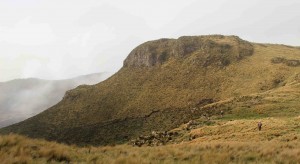
Soon after breakfast, a thick fog rolled in. We started the hike down to Darjeeling Cliff where the geladas had spent the night. I wore the waterproof rainboots I had worn the previous two days, but found were killing my feet. It didn’t look like rain, so I returned to camp and put on the Kiboko soccer cleats that I had brought for Gombe. Much more comfortable.
We hiked several kilometers down to the cliffs, and found some of the geladas already up at the top, basking in the sun, grooming, and starting to feed. We followed them as they traveled in a long circuit through the open hills. This southern area looked strangely like the Great Basin in the American West: grassy hills and open plains studded with stark masses of rock, the bushy grey-leaved Helichrysum filling in for sagebrush.
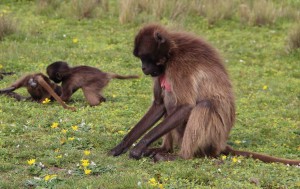
The geladas ate and ate, sitting on their bottoms, plucking grass and herbs with their nimble hands and stuffing their mouths. So many monkeys plucking grass at once made a surprisingly loud munching sound, rather like a horde of locusts.
Geladas have such an interesting social system – one with some interesting parallels with human society. Like humans, geladas live in a multi-level society with strong bonds between males and females. They travel in herds made up of one-male units (OMU’s). Each OMU has a leader male, a ‘harem’ of females, their offspring, and sometimes one or more follower males. Each leader male tries to keep all the females in his harem to himself. But because the OMUs travel together in herds that may have hundreds of monkeys, there are always other males around, particularly the bachelor males, who hang around the periphery in menacing groups of unattached males.
In my own research, I focus on chimpanzees, which are much more closely related to humans than are gelada monkeys. The last common ancestor of chimpanzees and humans lived something like five to six million years ago, whereas the last common ancestor of humans and Old World Monkeys such as geladas lived perhaps 30 million years ago. But social structure can evolve quickly in response to ecological conditions and other factors. And in some ways, geladas, living in open country, may face ecological circumstances that are rather similar to those faced by our hominin ancestors, who also lived in the more open habitats of East Africa, compared to chimpanzees, which live in forests and woodlands.
In chimpanzees, males and females don’t have strong social bonds or anything like marriage. Instead, females attempt to mate with many different males. Males may try to keep other males from mating with a particular fertile female, but unless the male is especially intimidating, or manages to sneak off on consort with a female, the female usually mates with multiple males. The result is that chimpanzee males don’t know for sure who their children are, and no chimpanzee knows for sure who his or her father is. Even the researchers studying chimpanzees, keeping close tabs on every mating, couldn’t be sure who the fathers were before the advent of genetic paternity tests.
In contrast, in gelada monkeys, males and females do have strong social bonds. Each leader male grooms and herds and mates with and jealously guards the females in his harem. As a result, gelada monkeys likely do know who their daddies are.
There are other primates, like gibbons and titi monkeys, in which males and females live in monogamous pairs, with strong male-female social bonds. And there are other species, like gorillas and blue monkeys, where groups usually have a single male and harem of females. What is unusual about geladas is that they, like humans and a few other species, live in societies with strong bonds between males and females, not as isolated family units, but as members of complex multi-level societies.
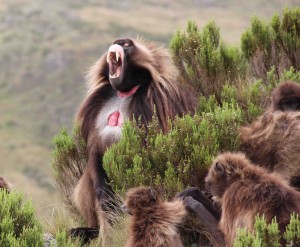
Because competition for mates is intense, males are big and showy, nearly twice the size of females, with massive canines and flowing manes of hair. With their big hair and strutting posture, they look like heavy metal rockers, and they have been giving fitting names: Lars, Danzig, Ulver, Mustaine.
In the mid-afternoon, the geladas plucked short grasses from a meadow strewn with yellow flowers. Around 120 monkeys foraged together. We were closest to a one male unit led by Ptolomy. Though he was clearly the leader male, he still had to contend with two follower males: Cthulu, who had briefly reigned before Ptolomy deposed him, and Tony, who had enjoyed a long reign before being overthrown by Cthulu.
A female with a full red chest, Tatanga, presented to Ptolomy. He started to mate with her, but then he looked over and saw Tony, some thirty yards away, flashing his eyelids at him. How dare he! Though Ptolomy had just begun mating, he dismounted Tatanga and strode threateningly to Tony, who flipped his upper lip over his teeth, staring back at Ptolomy. Cthulu stood behind Tony, lending his support. Tony carried a baby on his back – probably one of his own babies, since he had enjoyed a long tenure as leader male. Males often use infants in fights with other males, though nobody really knows why they do this.
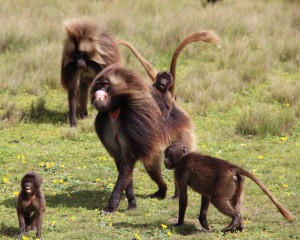
Ptolomy walked right up to Tony and stared into his face. Tony kept his lip flipped up and opened his jaws, showing off his huge canines. Cthulu flipped his lip and showed off his own fangs. This was the last straw for Ptolomy, who lunged right at both of them – and soon ran off into the hills, with the other two males chasing right behind him. To me, it looked like Ptolomy had been chased off by the other, lower ranking males, which surprised me. Peter explained, though, that such interactions often ended up that way. The leader males often ran ahead, letting the lower ranking male chase them. Maybe the leader males do this to show off their stamina.
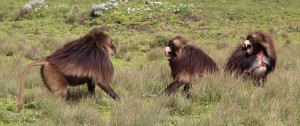
So Tony, despite being an old deposed former leader male, could still get away with interrupting the new leader male’s mating efforts. And Tony seemed always to be surrounded with little kids, who were almost certainly his.



Fascinating! I wonder whether bringing a kid into the (potential) fray affects the relative degree of violence or likelihood of injury (or do episodes like this generally end without actual combat anyway?) Also, do males ever move between OMUs (i.e. would Tony only see Ptolomy as the one to be displaced, or might he decide to go find some other reigning male to challenge and potentially displace?)
It might! One possibility is that males that grab an infant are exploiting an inhibition that other males have against attacking infants. This doesn’t seem entirely plausible, though, because males commonly commit infanticide when they take over a new group, killing the youngest infants so they can get an earlier start on siring their own brood. Another possibility is that the kids may work as hostages — “This kid might be yours, and if you attack me it might get hurt, so you better leave me alone.” But in the Tony vs. Ptolomy case, this doesn’t work, since Tony (who had a baby on his back) is the likely father. Another possibility is that males are protecting their own infants from aggression from other males. This might be the case here, but it doesn’t completely make sense, since wouldn’t the kids be safer if you just kept them out of the fray? It’s all very puzzling and interesting.
Males do move between OMU’s. New males can come in to take over, and deposed males may leave to try their luck as followers in another OMU.
Most day-to-day fights like this are more bluff than bite, but fights for control of an OMU are fierce and can be deadly.